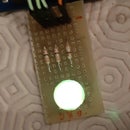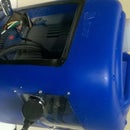Introduction: Birdhouse Plant Climber
Last summer, we decided to give the garden a complete overhaul and restored the shed. The old birdhouse was also in a bad state so we decided to make a new one too.
Where we live, it is usual to build houses with the garden over a tunnel which leads to the garages. In our case, the ground of our garden is only approx 40-50cm deep. For this reason, we could not drive a bird house pole into the ground and expect it to stay up for long. Hence, we had to think of a way to make a stable base so that the birdhouse would not get blown down by strong winds for example.
There are plenty of instructables for birdhouses but we decided to make our own design:
1. Because we wanted to incorporate a plant trough for climbing, flowering plants and make the bird house more colourful!
2. The trough acts as a weight and gives extra support.
I do not consider myself an expert craftsman so my instructables are just to give an idea. I am sure the experts will make a better job and if they would like to give some advice or suggestions then I will be very pleased!
Step 1: Choose Your Trough
The dimensions are for my plant trough and are only indicative because it depends on the plant trough / vase you decide to use. My trough was 20cm x 45cm. So go and buy a plant trough you like most and make the frame accordingly.
Step 2: Safety First!
Always wear goggles gloves and other protective gear when doing such work and especially when using power tools.
Some tools, such as angle grinders and welders, are potentially very dangerous. Follow this instructable at your own risk, I am not responsible if you get hurt or cause damage to yourself or others; especially If you don't know how to use the tools mentioned in this instructable. Make sure the finished bird house is securely anchored to the ground. To be super safe, you may also like to attach warning signs etc to prevent people, children or animals etc trying to climb on it!
Step 3: Making the Frame
Before you start, please download the drawings of trough holder in PDF
Many thanks to my son Stefano who drew most of it using Autodesk Autocad 2016 student version. The student version is a free, 3 year trial version for students. It is good because it allows students to try and learn a professional version which most industries use.
I don't like working with metal much (I am sure you can see!) but I do it when I have to!
I used some old metal fence posts to make the frame. As I mentioned previously, the size of the frame depends on the size of your trough. You need to measure the base of the trough and make the frame accordingly. You can see my frame has a large rectangle for the trough to sit in and a smaller rectangle that acts as a spacer. The smaller one should be wide enough so that the outer edge is in line with the rim of the trough.
Put each piece of metal securely in a vice and cut with an angle grinder or saw. Use a thin cutting blade.
Lay all the pieces on the floor and in the shape of the frame, as shown in the photo. Trim any parts if necessary. I also had to remove the paint before welding. Hence remove any paint, dirt or grease etc. with a wire brush or abrasive disc.
When welding the parts together, use a metal square / jig to make sure the parts are welded together squarely.
Attachments
Step 4: Choose You Branch
Now you need to choose a suitable branch so that we can make the support bracket to suit.
I did not cut any trees down but found a branch that had already fallen off a tree! My branch was not very interesting but did the job. Try to look for a strong one and one which is not too big and heavy.
Step 5: Make the Bracket for Your Branch
Now we have our branch, we can make the support bracket.
Measure and cut the parts so that, when the middle of the branch is on the end of the bracket, the side of the branch almost touches the rim of the trough.
1. Weld a piece of flat metal bar to the base as shown in the photo.
2. Weld another flat metal bar across the middle of the previous bar.
3. Now you need an 8mm hex head bolt which will be act as a spike in the ground.
Using a bench grinder, make a point on the end of the 8mm bolt and weld it in the middle of the two metal bars as shown.
4. Now take an 8mm hex head screw and weld on to the same metal bars but on the opposite side of the bolt as shown in the photos and drawing.
5. I added two extra pieces of angle in a vertical position in order to give more support.
Unfortunately, I have not done the welding course and so my welding is not fantastic. However, it does the job and I hope does not make the expert welders feel too sick by the sight of it!
Now the metal frame is ready, you can paint it with some anti-rust paint of your choice.
Step 6: The Birdhouse
Make sure you download the drawing of the birdhouse in PDF. However, If you don't like my version, there are also plenty of other designs of birdhouses on instructables too.
I used some scrap wood, from old pallets, to give a rustic look.
Measure and cut all the shapes. I made the house in two parts: upper part and lower part.
To join the two areas together, I used a small piece of branch (support branch).
Cut the support branch to the size required.
Once all the parts have been cut for the upper part, glue them together and add extra strengtheners in the corners.
Don't forget to cut the hole for the birds to get into the house!
Attachments
Step 7:
Before you put the roof on, cut a piece of branch and, using glue and a screw, fix it under the entry hole. If you put the screw into the wall of the house first, the piece of branch can be screwed onto it.
Step 8:
Next, drill holes in each end of the support branch and then, using glues and screws, fix the support branch onto the lower part of the house (the base).
It is better to put the branch in a bench vice and drive a screw in from the bottom of the base.
In my case, I then fixed the lower, base part assembly onto a larger branch that will act as a support later. It is best to do this before fitting the upper part of the house.
Step 9:
Position the upper part of the house onto the support branch and mark the position for drilling screw holes.
Drill suitable holes where the base of the house rests on the support branch.
Now fix the upper part of the house, onto the lower part assembly, by driving screws through the floor of the upper part into the end of the support branch.
Step 10:
Now the roof can be fitted with glue and small screws.
Once assembled, the house should be painted in order to protect it from the weather.
I used a transparent varnish, for outdoors, and painted the whole bird house with 3 coats of paint.
To cover the roof, I used a sheet of plastic and fixed it with staples.
Later I covered that with thin cork sheets for extra protection. However, I did not pain the inside and (since writing this instructable) the wood for the roof got damp and curled up! and Hence, I will need improve!
I will replace the roof and paint the inside of the house first. I will then cover with roofing felt or a thin sheet of metal such as copper.
Finally you can glue twigs / string onto the edges of the house to decorate it a bit. I used twigs.
Step 11: Finally Assembly!
Now the house is ready!
take everything into the garden:
1. Place the base on the ground and push the spike (which is welded onto the bottom of the metal frame) into the ground.
2. Screw the branch onto the vertical screw( which was previously welded onto the metal frame).
3. Fit the house to the main branch. I used wood screws but I suppose you can use string or wire to attach it too.
4. Fit the trough and fill with soil.
5. Plant your favourite climbing plants. (We used a mixed variety).
6. Put some bird food in the feeding area and wait for the birds to arrive! It took approx. 10 days for them to go near the new bird house but now they visit quite regularly (I will soon be able to enter the BBQ contest!) ...only joking!
7. It also took a while for the climbing plants to grow and flower but I think the end result is quite pleasant and worth the wait!

Participated in the
Epilog X Contest














